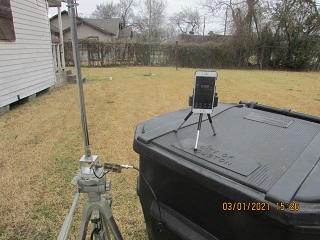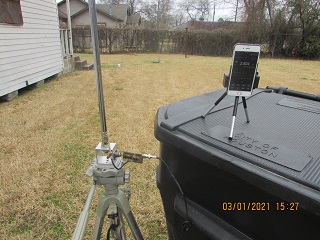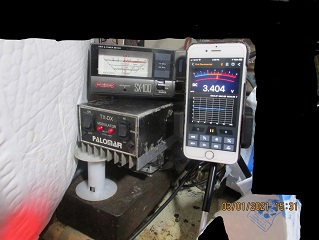
My Bluetooth Wireless Field Strength Meter Setup

|
Notice The field strength meter receiving antenna on the tripod is placed 36 feet from the transmitter antenna under RF power, and it is reading the RF voltage on the cell phone screen through the wireless Bluetooth. So as the RF power is increased to the transmitting antenna, then the field strength meter receiving antenna on the tripod must be increased in distance from the transmitting antenna, or put a 50 ohm dummy load on a T connector along with the RF probe that would reduce the RF voltage to 1/4 or -6 db attenuation; or else the RF probe would have high chance of getting damaged by the high RF power from transmitting antenna if the transmitting antenna is too close. So always start out with low RF power first to the transmitting antenna, and then gradually increase RF power, and don't let it exceed the reading of 70 volt on the field strength meter, or else the RF probe would have a high risk of getting damaged by the high RF power. |
Click On Pics Below
 |
 |
 |
 |
|
This field strength meter is calibrated to read RF AC voltage in rms, and you could calculate db gain of a directional antenna. If you want to calculate db gain of the directional antenna over a reference antenna like a db gain over single mobile antenna, or a db gain over a dipole antenna as known as dbd, or db over an isotropic antenna that is imaginary as known as dbi; 1st, you must set up a reference antenna to measure the field strength voltage, then set up the directional antenna measure the field strength voltage, and then calculating the db (decibels) by using the formula below. The reference antenna could be a single antenna mounted on the automobile, or a dipole antenna mounted on a mass pole. Make sure the field strength meter antenna is set the same distance from the transmitting antenna in order to compare more accurately. Most radio amateur antenna manufacturers rate their antenna gain at dbd (decibel gain or loss over a dipole antenna), and most CB radio antenna manufacturers rate their antenna gain at dpi (decibel gain or loss over an isotropic antenna). So the most basic practical antenna is a dipole antenna. When you measure the field strength voltages to calculate db gain, 1st measure field strength voltage from the reference antenna like a dipole or a ground plane antenna, and then measure field strength voltage from the directional antenna or a higher gain antenna; after you have taken both voltage measurements, then use those formulas to calculate the db gain:
*Note: negative db is loss, and positive db is gain After you have measured the field strength voltage of the reference antenna and directional antenna or a higher gain antenna, use this formula right below to calculate voltage gain or loss to decibel: db = 20 x log (E2 / E1) Note: That negative db (decibel) number means loss, and positive db number means gain: To convert voltage factor to power factor: power factor = (E2 / E1)² To convert decibels (db) to power factor: power factor = 10(db / 10) In order to calculate dbi (decibel gain over an isotropic antenna), 1st you must compare the 2 field strength voltages of a dipole antenna and a directional antenna or another antenna by using that formula above in order to find the dbd gain (decibel gain over a dipole antenna), and then use that formula below calculate to convert dbd to dbi, or vice versa: To convert dbd to dbi, and vice versa, use this formula: dbi = dbd + 2.14 OR dbi = dbd +10 x log (1 + 2 / π) dbd = dbi - 2.14 OR dbd = dbi - 10 x log (1 + 2 / π) To calculate power gain or loss to decibel: db = 10 x log (P2 / P1) To calculate decibels (db) to voltage factor: voltage factor = 10(db / 20) If you are measuring the field strength from a transmitting antenna
|
||||||||||||||||
|
Notice This webpage is subject to change without any notice in order to improve more accurate information. |
By you entering the website,
you must agree to the terms: Click here
Copyright 2021 24hourcb.com